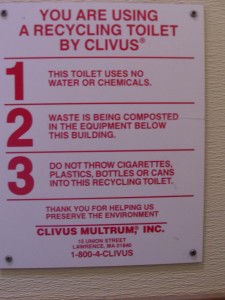 Resource Management
Resource Management
On a daily basis the average American wakes up, brushes their teeth, showers, flushes the toilet, and drives to work. During their lunch break they usually drive somewhere to get a meal, and drive back to work. After work they drive home, make dinner, maybe watch some television or read a book, and then go to bed.
While living on the Gato Verde for about three weeks, we learned a lot about the resources we use on a daily basis and some of the thing we take for granted, like water. Every day we measured how much water was used and calculated the amount of water we used per person per day. On average we had 6 people living on a 42 foot catamaran using 18 gallons per day, or approximately 3gallons/person/day. I assumed this was a significant amount of water to be using, considering it was only used to wash dishes by hand, brush teeth, flush the toilet in the head, and occasionally wash hair. After doing a bit of research I was surprised to learn that the average American per day uses 80-100 gallons of water. Most of this water is used for bathing/showering and flushing a toilet. With such a large amount of water being used every day, by each person, it is astonishing that many of us never think about the amount of water we are using, and where it is coming from. Because water is so accessible to most Americans, it seems that we often forget not only the amount of water that we are using daily, but also the other resources being used so that we can have water at the turn of a faucet.
While it is nice to have the convenience of water at our finger tips, it is important to remember that clean, useable water is not easy to acquire in many parts of the world, and there are many costs associated with using such a large amount of water. Next time you flush your toilet, think about how much water was just use, and how many chemicals will be needed to treat the waste water before it is sent back out into the environment.
Read More
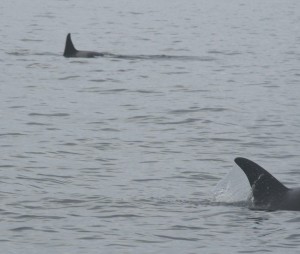
Foraging Behavior?
While there is a lot of information that we do know about the southern resident killer whales, there is so much information that still remains a mystery about these great predators. It has been established that the southern resident killer whales mainly eat Chinook salmon, which makes up 65% of their diet. Research has also shown that Chinook salmon within the home range of the southern resident killer whales are also endangered (Hanson, 2007). In addition to knowing their diet; their family structure, life span, age of sexual maturity, and vocalizations used by these predators are known as well. With all of the knowledge we do have about the southern resident killer whales, there are a lot of things that we can only speculate about. One thing that remains unclear is what the vocalizations of these whales mean.
While on the Gato Verde I focused on one specific question, which was – can killer whale click rates tell us anything about foraging behavior? Researchers have found in several species of toothed whales that there is a relationship between acoustics and foraging behaviors (Simon, 2007). Because so much of a killer whales activities take place under water where visability s limited, this question was particularly hard to answer.
I was unable to find a direct correlation between foraging and click rates from the data I collected, however I am still interested in further exploring this question. Further research on this topic would perhaps give me a more definitive answer, and it would be useful in determining what activities are taking place in their underwater habitat. While the answers I found through my own project were not entirely satisfactory, this project did heighten my curiosities about what the clicks produced by killer whales could be telling us. I would recommend that others explore this topic as well, so that one day we will have a definite answer to what their vocalizations mean.
Read More
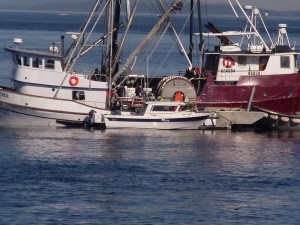 Concerns about overfishing are a pressing issue. Technological advances, have made fishing industries much more efficient. Fish are caught at greater depths, and in much larger numbers. Some scientists have estimated that as much as 90% of large predatory fish including sharks, swordfish, and cod have been removed from the oceans of the world . With so many large predatory fish having been removed from the ocean it may seem that there are plenty of other fish in the sea, however this is untrue for a growing number of fish populations. Other factors, including pollution, fishing methods, and habitat destruction contribute to the decline of many fish populations, including Chinook salmon.
Concerns about overfishing are a pressing issue. Technological advances, have made fishing industries much more efficient. Fish are caught at greater depths, and in much larger numbers. Some scientists have estimated that as much as 90% of large predatory fish including sharks, swordfish, and cod have been removed from the oceans of the world . With so many large predatory fish having been removed from the ocean it may seem that there are plenty of other fish in the sea, however this is untrue for a growing number of fish populations. Other factors, including pollution, fishing methods, and habitat destruction contribute to the decline of many fish populations, including Chinook salmon.
As we have learned, Chinook are the preferred prey of the endangered southern resident killer whales. These salmon are also listed as endangered. Habitat degredation, genetic and ecological impacts from hatchery production, and impacts from hydropower are factors that put these fish at risk. While Chinook salmon make up 65 % of the southern resident killer whales diet, and are of upmost importance to this population of killer whales, they are also consumed by many other marine animals. As specific fish populations become threatened or endangered, so do the predators that depend on them as a food source.
Understanding relationships between predators and their prey is crucial to maintaining, and sustaining the environment in which all living creatures share. Establishing the importance of all members contributing to an ecosystem further emphasizes the importance of practicing sustainability. It is important to remember that the environment in which we live is delicate and can be manipulated easily. It is up to all members of society to establish methods for fishing that will not devastate the environment in which they live, and share.
Read More
As all the 112 Beam Reach students (Sharon, Laura, Hayley, and Charla) can recall the phrase we heard the most was “this never happens†or “this is a firstâ€. After hearing it a few times we decided to keep track of all the so called “firsts†for Beam Reach.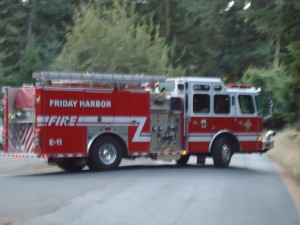
- Seeing a fire truck and an ambulance zooming through campus – “This never happens at Friday Harbor Labs!â€
- First year observing at Lime Kiln – “You are the first Beam Reach class to be able to use the Lime Kiln as a research base… so now you get to clean the acoustic shed, YEAH!”
- Residing in T2 (with carpet) compared to S1 – “This is a first, we have only had S1 in the past…and there is carpet!â€
- Most organized and clean group of students – “Your dishes are so organized all the time; this is a first for Beam Reach.â€
- Most whale days – “You guys are so lucky this never happens.”
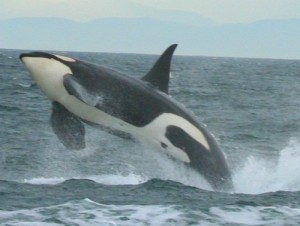
Breaching Southern Resident
- Most Dall’s porpoise off the bow – “It’s rare to NOT see Dall’s but never this much.â€
- First Canadian – “Charla is the first Canadian to be a part of Beam Reach – CONGRATS!â€
- First conference (Salish Sea Ecosystem Conference) – “This is the first time Beam Reach is going to a conference and presenting posters”
- Lunch with John Ford – “I bet this is a first for Beam Reach, lunch with a science celebrity… John Ford!”
- Most rainbows (single and double) – “Want another Beam Reach first… the most rainbows!”
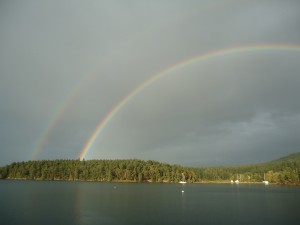

Students collecting data at Lime Kiln
After an eventful quarter at sea collecting data we finally had the opportunity to analyze it and see our results. We presented posters at the Salish Sea Ecosystem Conference in Vancouver, Canada. We, the students, presented posters, talked with many scientists, and sat in on 3 days of presentations. We were all extremely blessed to have received this opportunity as it has helped in networking and giving us a glimpse in the scientific world. We will now all go our separate ways, but we will never forget the Beam Reach experience!
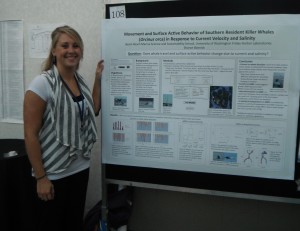
Sharon with poster at Salish Sea Ecosystem Conference
Read More
All the times we missed the orcas passing the Lime Kiln during our land-based research were about to be made up for…
Once we were aboard our catamaran home, our lives could basically revolve around the movement of the orcas, and it didn’t take long for that to begin. Since we started taking data on the whales right from day one, we had to take what we had learnt at the Lime Kiln and adapt quickly to data recording at sea.
“Permission to Deploy the Arrayâ€:
Once the whales were around us, we would deploy a four hydrophone array from the back of the boat and start recording. Laura listened to the calls and clicks being recorded in one minute time segments and recorded what she could hear on a phonation sheet so we could go back and listen to the best recordings afterwards. We also played the hydrophones through the speakers throughout the catamaran, so even those of us not working on the acoustics could have the full effect while we were with the whales.
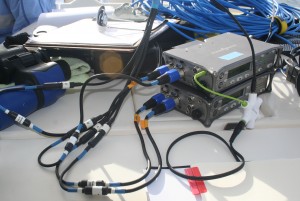
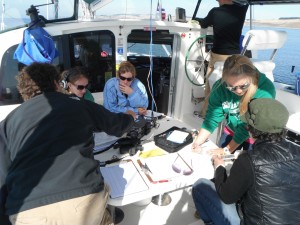
The hydrophone array recording equipment (left) and the team preparing to record the whales on our first day (right).
“Two whales, 12 o’clock, 200 meters, traveling North!â€:
Sharon and I were on behaviour lookout. The idea was to call out every whale we saw with a clock bearing, a distance, and what activity they were doing, while Hayley wrote all this information down on a behaviour sheet. We were also specifically recording surface active behaviours (such as tail slaps and breaches) and foraging behaviour for our own projects. Sounds simple enough, but when you have anywhere from 5 to 50 whales in sight, 360 degrees around the boat, things got pretty crazy (but crazy in the best way possible, this is what we were here for!).
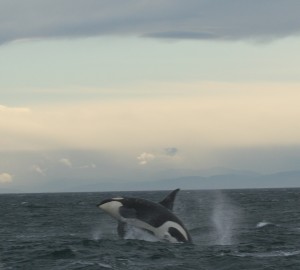
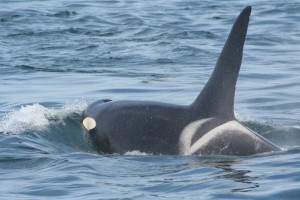
An orca breaching (left) and J26 – “Mike” swimming past the Gato Verde (right) during our data collection.
Since Beam Reach 112 had some of the most orca encounters while out on the water, this routine was continuously practiced and fine tuned, but every so often there were days without orcas where we could experiences some other aspects of life at sea.
While the orcas are away:
One of our other main focuses while living at sea was learning about sailing. We had lessons beginning with all the basic parts of a sail boat, and progressing through raising the sails, choosing an appropriate sailing course, steering, tacking and jibing, and learning the right of way rules. It was great experience going through all the steps required in order to sail, and to help eachother learn along the way. We even had the opportunity to sail with some near gale-force gusts making it all the more exciting.
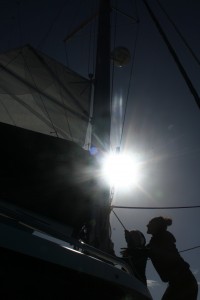
Preparing to raise the main sail
We also quite often had some other playful cetaceans visit us while the orcas were out at sea. Dall’s porpoises would bow-ride infront of us, most often near the Lime Kiln. We would lie on the front on the boat and watch them swimming just a couple feet below us. Some would even turn on their sides to get a better look at us and then come up to give us a splash, seemingly on purpose. We even thought we could hear them clicking on our “listening hydrophone” we had deployed one day as they approached our stationary boat.
Dalls Porpoises Bow-Riding the Gato Verde
Other research we conducted while the orcas were away included CTD casts, which took the whole team to lower the CTD (an instrument used to obtain a depth profile of temperature, salinity, and various other water measurements) 60 meters into the water, and then use a winch to crank it back onto the boat. I also fished for salmon and analyzed fish finder data from the boat for my project while the orcas we away, and had great success doing so!
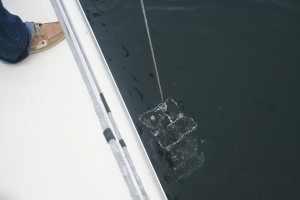
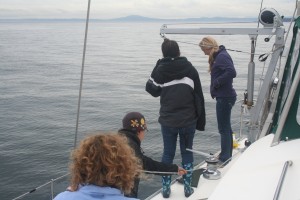
The CTD in the water (left) and the crew waiting to haul it back up (right)
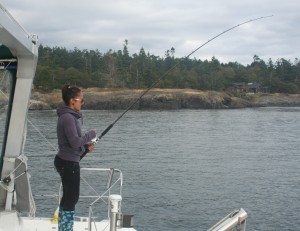
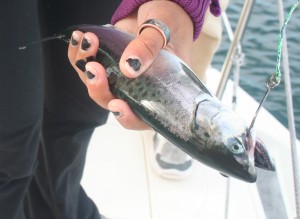
Salmon fishing off the boat (left) and a successful catch of a juvenile Chinook (right).
Read More
 Resource Management
Resource Management


















 Twitter
Twitter LinkedIn
LinkedIn Facebook
Facebook